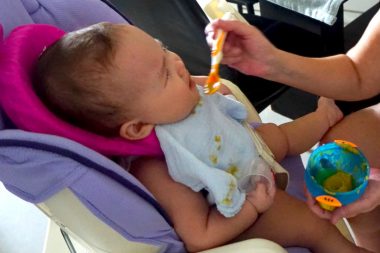How We Manage Our Daughter’s Blood Sugar Levels to Avoid a Hypoglycemic Crisis
Written by |

As the sun crept higher into the beautiful morning sky, we decided to eat breakfast at a nearby park. The short walk would delay our normal breakfast time, but it seemed like a wonderful idea. But as we sat down to begin the picnic, our daughter’s skin turned noticeably pale, and she worryingly gazed off into the distance. We tried to get her attention by feeding her some oranges, and slowly, the color returned to her body. But she was more fatigued than usual, and she needed to sleep to recover.
Our 4-year-old daughter, Rylae-Ann, was experiencing a hypoglycemic crisis, or low blood sugar levels. A delayed meal and exhaust from the trip to the park most likely triggered it. We have a strict schedule for all of her activities, and nothing like this had ever happened before.
After she was diagnosed with aromatic l-amino acid decarboxylase (AADC) deficiency, we learned that autonomic dysfunction related to the disease might make her susceptible to hypoglycemia. We had never seen this symptom before, so we had thought we wouldn’t have to worry about it. The lesson we learned is it that it is something that families in our community should watch out for, as a severe hypoglycemic crisis is a recognized symptom of the metabolic dysfunction in AADC deficiency.
After that episode, I was worried about how we would prevent it from happening again. Thankfully, it is not difficult to do, and it requires only following some simple protocols. If you’re a parent looking for guidance on this issue, in addition to working with your pediatrician, the following practices that worked for our daughter might be insightful for you.
Diet
The first action we took was to have healthy meals and snacks prepared. We made sure our daughter had three healthy meals spaced throughout the day. Also, before she fell asleep or woke up, we would have a snack ready for her that included complex carbohydrates and some fat, if possible. We usually gave her cheese and crackers with cold cuts. In addition to food, it was important that any medications or supplements were given at the scheduled times and not skipped.

Rylae-Ann eats three main meals scheduled regularly throughout the day, along with healthy snacks before and after sleeping. (Photo by Richard E. Poulin III)
Schedule
Meals, snacks, and medicine were all coordinated and scheduled. Her three major meals were regularly spaced to happen in the morning, afternoon, and evening. She wakes up at 6 a.m. and is in bed by 7 p.m., which means our family meals together are centered around her sleep schedule.
We eat as a family, which allows us to ensure safe feedings. Eating together assured that we were working as a team to keep her upright for at least 30 minutes after feedings while someone took care of the cleaning.
We continue to maintain this schedule, which is paramount to all of our plans. We prepare food before any outing or long trip. Missing a meal never happens. In the event we have to delay a meal, we find a snack and monitor for symptoms of low blood sugar. Having a blood-testing kit helps to monitor glucose levels.

We make sure to have preplanned meals and snacks ready for Rylae-Ann, no matter where we are. (Photo by Richard E. Poulin III)
Blood testing
We recently began doing blood testing at home. Diet and schedule alone ensured our daughter never had another attack. However, I wanted more data about her levels. Knowing how her blood sugar level fluctuates could provide important insight later in life, so we purchased a blood sugar testing kit.
The glucose monitoring kit includes a simple-to-use device that provides a reading in seconds. It stores blood data collected from a relatively painless prick. It can be purchased without a prescription online or at a local pharmacy. Several options were available that included everything in a portable kit, but we bought a popular device to ensure that we could easily find compatible lancets and test strips when it comes time to refill.
Continuous glucose monitors are another option. They have the added advantage of providing blood-free readings, but this type of device was not recommended for us, due to our child’s age. Also, hypoglycemia symptoms are not a significant concern that require constant monitoring, so we did not consider this device.
We began by testing her blood before meals and snacks, before bed, and whenever there was a change in behavior or schedule. We will continue with this plan and collect the data. After reviewing the results, we will decide if we want to limit or discontinue testing unless there is a concern.
Medical alert cards
Managing Rylae-Ann’s blood sugar is an essential step in preventing complications. We make sure her support network is aware of the situation and able to manage these symptoms effectively. Another helpful tip is to have a medical alert card. In the event our daughter has an emergency, with the card, physicians can access critical information about her rare disease during an emergency in order to respond adequately.
Low blood sugar levels
If our daughter is showing hypoglycemia symptoms, we immediately provide sugary foods or liquids. Options include orange juice, cake icing, or glucose tablets. Easy-to-swallow foods or liquids are ideal for children with AADC deficiency due to difficulties with swallowing.
If she doesn’t respond to the sugary foods or loses consciousness, we would seek emergency help. Emergency contact information is available on the back of her medical card. However, by developing a healthy diet that has regularly scheduled meals and snacks, we no longer see any symptoms of a hypoglycemic crisis.
Note: AADC News is strictly a news and information website about the disease. It does not provide medical advice, diagnosis, or treatment. This content is not intended to be a substitute for professional medical advice, diagnosis, or treatment. Always seek the advice of your physician or other qualified health provider with any questions you may have regarding a medical condition. Never disregard professional medical advice or delay in seeking it because of something you have read on this website. The opinions expressed in this column are not those of AADC News or its parent company, Bionews, and are intended to spark discussion about issues pertaining to aromatic l-amino acid decarboxylase deficiency.







Leave a comment
Fill in the required fields to post. Your email address will not be published.